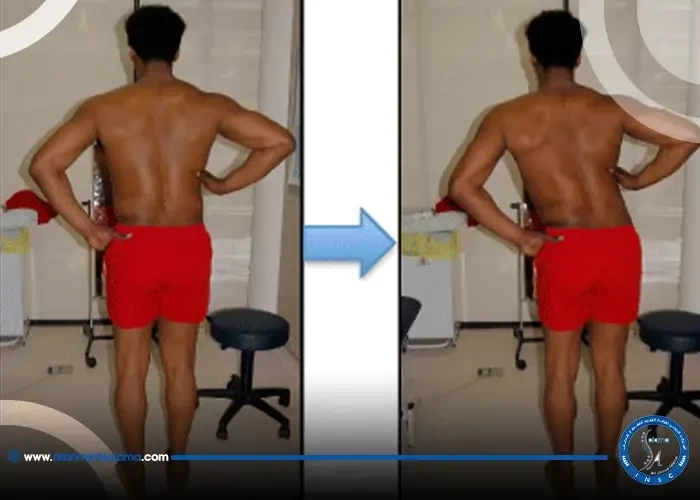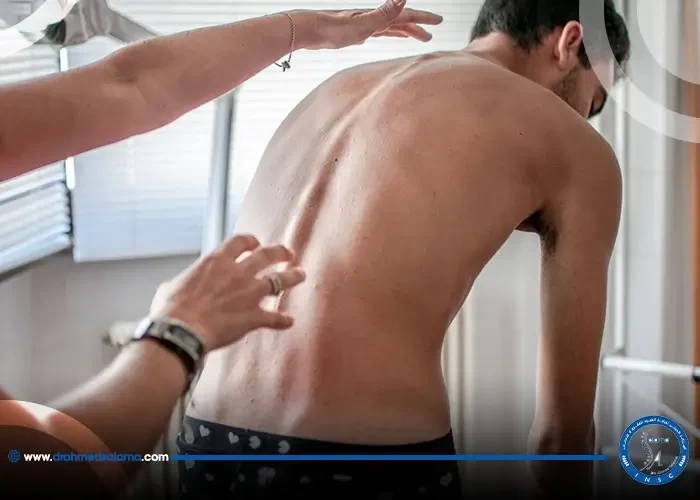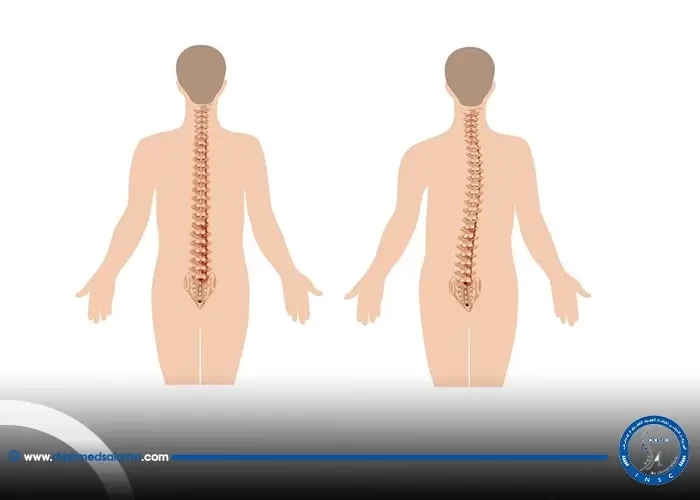Nasr City, 52 El Tayaran Street, in front of the Health Insurance Hospital

Symptoms of a herniated disc in the back

Are you experiencing pain, weakness or numbness in your back? It could be a sign of a herniated disc. A herniated disc occurs when the jelly-like substance inside the spinal disc leaks out and puts pressure on nearby nerves. This can result in a range of uncomfortable symptoms including back pain, muscle weakness, and even difficulty walking. In this blog post, we'll explore the common symptoms of a herniated disc in the back and what you can do to alleviate them. So, whether you're someone who has just started to experience these symptoms or someone who wants more information about this condition, keep reading!
Arm and Leg Pain
Arm and leg pain can be a major symptom of a herniated disc in the back. The pain may appear on one side of the body and be accompanied by sharp pain and numbness in the leg, hip, or buttocks. In some cases, low back pain may be the initial symptom of a herniated disc. When compressed nerves or pressure on the spinal cord occur, they can cause tingling or numbness and a feeling of weakness in the affected limb. It is important to seek medical attention if any of these symptoms occur, as an untreated herniated disc can result in debilitation and prolonged pain. There are various types of herniated discs, and treatment options will depend on the severity and location of the affected disc. However, there are ways to relieve pain caused by a slipped disc, including pain medications, physical therapy, and in severe cases, surgery.
Nerve Pressure Symptoms
One of the common symptoms of a herniated disc in the back is nerve compression which can lead to several nerve pressure symptoms. This may include dull or sharp pain in the neck, between the arms or legs, shooting pain in the foot, and numbness or weakness in the affected areas. Along with these symptoms, individuals may also experience pain on one side of the body and low back pain as an initial symptom. The intensity and severity of herniated disk symptoms can vary greatly depending on its type. But, it's crucial to seek proper treatment as an untreated herniated disc can cause significant debilitation, affecting spinal cord or important nerves. Fortunately, there are various treatment options, including nonsurgical approaches, which can relieve the pain and other symptoms. So, if you're experiencing any of the aforementioned symptoms, it's best to get medical attention to identify the root cause and to plan for appropriate treatment.
Pain on One Side of the Body
Pain on one side of the body is a common symptom associated with a herniated disk in the back. The pain can range from a mild ache to a sharp, shooting pain in the affected area. This symptom may also be accompanied by numbness, tingling, or weakness. If the herniated disk is in the lower back, the pain may radiate down the leg, while a herniated disk in the neck can cause pain to spread to the arm. It is important for individuals to seek medical attention if they experience symptoms of a herniated disk. Treatment options can range from rest and physical therapy to surgery, depending on the severity of the condition.
Sharp Pain and Numbness in the Leg, Hip, or Buttocks
Sharp pain and numbness in the leg, hip, or buttocks is a common symptom of a herniated disc in the back. The pain can be described as shooting or stabbing, and it may extend down the back of one leg, a condition known as sciatica. This type of pain often appears alongside weakness or numbness in the affected leg. The cause of this pain is the pressure on the nerve root that runs through the affected area, which can cause tingling, numbness, or a feeling of weakness in one or both legs. It is essential to seek medical attention if experiencing these symptoms, as they can lead to permanent nerve damage if left untended. In the following blog sections, readers can learn more about types of herniated discs, treatment options, and ways to relieve the pain.
Low Back Pain as a First Symptom
Many people experience low back pain as the first symptom of a herniated disc. This pain can be moderate or severe, and may last for a few days before improving. However, low back pain isn't always the only symptom of this condition. It's important to pay attention to other possible symptoms like arm and leg pain, nerve pressure symptoms, numbness or weakness in the affected area, and sharp pain in the leg, hip, or buttocks. Depending on the type and location of the herniated disc, other symptoms like difficulty standing or walking may also occur. Fortunately, there are various ways to relieve slipped disc pain, including physical therapy, medication, and even surgery in severe cases. It's crucial to seek medical attention if you suspect you may have a herniated disc, as early diagnosis and treatment can help prevent further complications.
Other Symptoms of Herniated Disk
Aside from arm and leg pain and nerve pressure symptoms, there are other symptoms associated with a herniated disc. Patients may experience sharp pain and numbness in the leg, hip, or buttocks, as well as low back pain as the first symptom. Tingling or numbness and a feeling of weakness may also be present. Other symptoms may include difficulty walking, standing, or sitting for prolonged periods, as well as a loss of bladder or bowel control. These symptoms may vary depending on the location and severity of the herniated disc. If you are experiencing any of these symptoms, it’s important to seek medical attention from a healthcare provider to determine the best treatment options for you. In addition to traditional treatments, such as medication or physical therapy, alternative options such as chiropractic care or acupuncture may also be beneficial in providing pain relief and promoting healing.
Types of Herniated Disk
When it comes to herniated discs, there are several different types that can occur. A lumbar herniated disc is the most common type and often causes leg pain. Cervical disc herniation affects the neck and can cause neck pain, shoulder pain, and arm pain. Thoracic disc herniation occurs in the middle of the back and is the least common. Additionally, herniated discs can be categorized as protruding, extruded, or sequestered based on the severity of the displacement. It's important to note that many people may have a herniated disc without experiencing any symptoms, while others may require various forms of surgical or nonsurgical treatment to find relief. If you're experiencing any symptoms of a herniated disc, it's important to consult with your healthcare provider to get an accurate diagnosis and appropriate treatment.
How to Relieve Slipped Disc Pain
When it comes to relieving the pain of a slipped disc, there are several things that can be done. Rest is the first line of defense, along with pain medication to help manage discomfort. Additionally, spinal manipulation can be useful in easing pressure on the disc and supporting the body’s natural healing process. Exercises and stretches that target the affected area can help to bring relief as well, while ergonomic support tools such as lumbar cushions and chairs can help to prevent future occurrences. In addition, hot or cold compresses can be used to soothe the affected area and reduce inflammation. While treatment options vary depending on the severity of the condition, there are many ways to alleviate the pain of a slipped disc and restore overall spinal health.
Tingling or Numbness and Feeling of Weakness
Tingling or numbness and a feeling of weakness are common symptoms associated with a herniated disk. The pressure of a herniated disk on a nerve root can cause these sensations in the affected area, whether it's the back, arms, or legs. Weakness may also occur in the muscles that are controlled by the affected nerve. If left untreated, these symptoms can worsen over time, making it important to seek medical attention. Treatment options can range from conservative approaches such as physical therapy, exercise, and medication to more invasive procedures such as surgery. It's important to consult with a healthcare professional to determine the best course of action for your specific situation.
Causes of Herniated Disk and Treatment Options.
A herniated disk can be caused by several factors, such as ageing, obesity, repetitive bending, lifting heavy objects or sudden trauma. In most cases, the condition can be treated without surgery, and nonsurgical treatment options may include physical therapy, chiropractic care, acupuncture, and medication to alleviate pain and inflammation. If nonsurgical treatments fail to provide relief, surgery may be recommended to remove the herniated portion of the disk. The procedure may involve a traditional open surgery or a less invasive technique, such as microdiscectomy. Successful treatment of a herniated disk depends on the severity of the condition, the patient's overall health, and adherence to treatment recommendations. Therefore, it’s important to follow the doctor's advice and engage in a healthy lifestyle to prevent the occurrence or recurrence of a herniated disk.
How do you know if you have a herniated disc?
There are some symptoms of a herniated disc in the back that the patient feels and that indicate the presence of a herniated disc, such as feeling severe pain in the neck if the disc is cervical, and feeling severe pain in the lower back if the disc is lumbar.
Herniated disc: When is surgical intervention necessary?
Surgical intervention may be necessary to treat a herniated disc if there is no response to medication or physical therapy, and if the symptoms of a herniated disc in the back do not improve over time.






